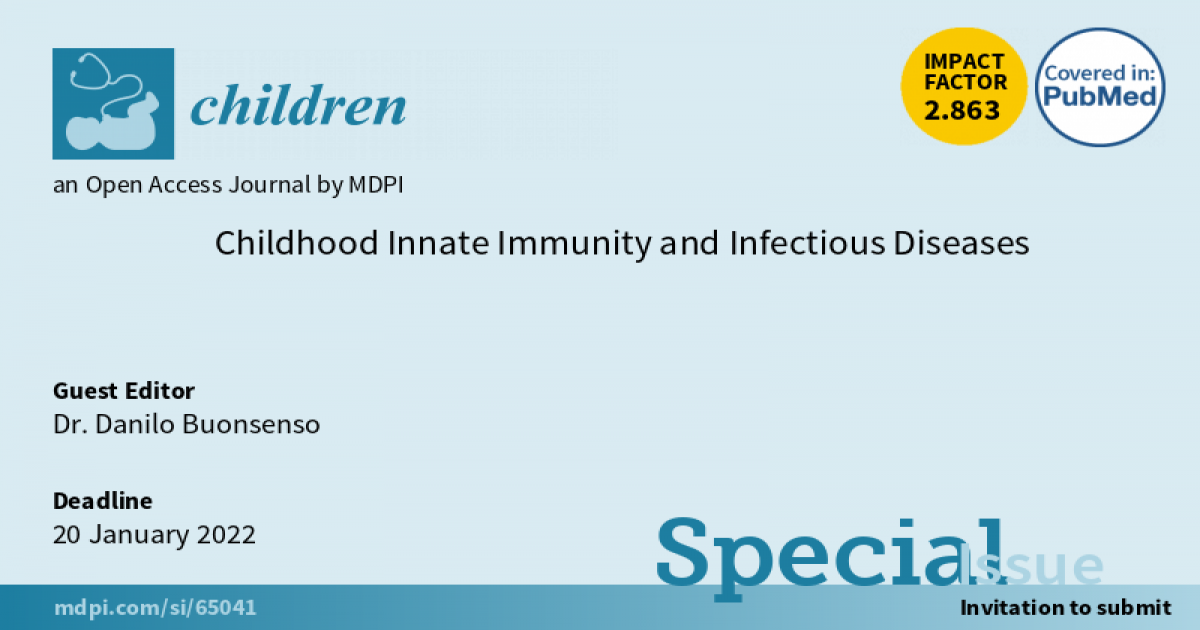Childhood Innate Immunity and Infectious Diseases
A special issue of Children (ISSN 2227-9067). This special issue belongs to the section "Pediatric Infectious Diseases".
Deadline for manuscript submissions: closed (20 January 2022) | Viewed by 21285

Special Issue Editor
2. Dipartimento di Scienze Biotecnologiche di Base, Cliniche Intensivologiche e Perioperatorie, Università Cattolica del Sacro Cuore, Rome, Italy;
3. Global Health Research Institute, Istituto di Igiene, Università Cattolica del Sacro Cuore, Rome, Italy
Interests: pediatric infectious diseases; global health; point of care ultrasound applied to infectious diseases
Special Issues, Collections and Topics in MDPI journals
Special Issue Information
Dear Colleagues,
Despite countless discoveries in medical sciences during the last few decades, several questions still remain unanswered. Unfortunately, the ongoing SARS-CoV-2 pandemic has opened the pandora’s box and reminded us of how much we still have to learn in several fields, from public health policies to basic science. Among the latter, the immune system is definitely among the protagonists. SARS-CoV-2, initially thought to cause a severe pneumonia (1), is now linked to a more complex systemic disorder where inflammation plays a primary role, causing a cytokine storm (2), endothelial inflammation predisposing to microclots (3), and countless more clinical effects. Not by chance, the majority of treatments studied have specific immune targets, and the most effective treatments so far, according to the higher standard of research, are once again steroids (4).
However, something is complicating the picture even more. Why are children, so far, less affected by the SARS-CoV-2 pandemic and frequently develop asymptomatic or paucisymptomatic infections? (5) Why is this happening, when millions of children die every year from other infectious diseases, including viruses? Why do some of them develop, weeks after the initial infection, a multisystem inflammatory syndrome? (6)
The immune system definitely hides the answers to these (7).
This pandemic is posing countless challenges for all of us, but it is also giving us the opportunity to learn more and, hopefully, prepare a better future to next generations. As members of the scientific community, we aim to take the chance to learn more, train new generations of healthcare workers, and inspire. This is why we are calling you to contribute to a Special Issue on “Childhood Innate Immunity and Infectious Diseases”, aiming to provide both high-quality reviews and original studies that both educate and inspire the scientific community and the younger generation of healthcare workers and researchers.
We are particularly interested in the following topics:
- Innate immunity from the newborns to adolescents (reviews and new findings);
- Innate immunity, BCG, and tuberculosis;
- Innate immunity and immunizations;
- Innate immunity and bacterial infections of major pediatric interest;
- Innate immunity and viral infections of major pediatric interest, including SARS-CoV-2;
- Childhood microbiota and innate immunity.
Dr. Danilo Buonsenso
Guest Editor
Manuscript Submission Information
Manuscripts should be submitted online at www.mdpi.com by registering and logging in to this website. Once you are registered, click here to go to the submission form. Manuscripts can be submitted until the deadline. All submissions that pass pre-check are peer-reviewed. Accepted papers will be published continuously in the journal (as soon as accepted) and will be listed together on the special issue website. Research articles, review articles as well as short communications are invited. For planned papers, a title and short abstract (about 100 words) can be sent to the Editorial Office for announcement on this website.
Submitted manuscripts should not have been published previously, nor be under consideration for publication elsewhere (except conference proceedings papers). All manuscripts are thoroughly refereed through a single-blind peer-review process. A guide for authors and other relevant information for submission of manuscripts is available on the Instructions for Authors page. Children is an international peer-reviewed open access monthly journal published by MDPI.
Please visit the Instructions for Authors page before submitting a manuscript. The Article Processing Charge (APC) for publication in this open access journal is 2400 CHF (Swiss Francs). Submitted papers should be well formatted and use good English. Authors may use MDPI's English editing service prior to publication or during author revisions.
Keywords
- Immune system
- Microbiota
- Innate immunity
- Viral infections
- Bacterial infections
- Immunizations






